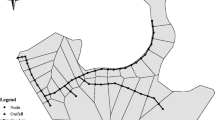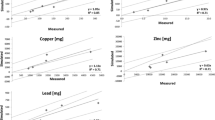Abstract
Different linear transfer functions (TFs) models are compared to the traditional non-linear rating curve (RC) model in a novel event-based exploratory frame. This approach aims to scrutinize for alternative representations of the stormwater TSS load dynamics at the output of a 185-ha urban catchment, when not considering explicitly a virtual state of available pollutant mass accumulated during the dry weather and subsequently washed by rainfall (as a simplification of the widespread accumulation/wash-off model). The advantages of using TFs remain unproved compared to the RC model, which shows more performant results in terms of parsimony and simulation uncertainties with a dataset of 255 calibration and 110 verification online-monitored rainfall events. This can be explained by the non-linear properties of RC. Modeling performance when rainfall is used as the input remains lower than for the case of flow rate (from mean NS of 0.6 to 0.4 in verification events). On the other hand, the RC by itself can be still considered an unsatisfactory model (e.g., NS about 0.6 in verification with the flow rate as input), suggesting the lack of an essential missing process in this formulation. However, this missing process (if there is one) might not be necessarily linked to a time-decreasing state of available pollutant mass.








Similar content being viewed by others
Data Availability
The data used in this work have been collected and made available by the OTHU project in Lyon, France (see www.othu.org).
Code Availability
Not applicable.
References
Sartor, J. D., & Boyd, G. B. (1972). Water pollution aspects of street surface contaminants. Washington DC: US Environmental Protection Agency.
Deletic, A., Dotto, C., Fletcher, T. D., McCarthy, D. T., Bertrand-Krajewski, J. L., Rauch, W., Kleidorfer, M., Freni, G., Mannina, G., & Tait, S. (2009). Defining uncertainties in modelling of urban drainage systems. 8th International Conference on Urban Drainage Modelling (pp. 7–11). Tokyo.
Bonhomme, C., & Petrucci, G. (2016). Should we trust build-up/wash-off water quality models at the scale of urban catchments? Water Research, 108, 422–431. https://doi.org/10.1016/j.watres.2016.11.027
Sandoval, S., Vezzaro, L., & Bertrand-Krajewski, J. L. (2018). Revisiting conceptual stormwater quality models by reconstructing virtual state variables. Water Science and Technology, 78, 655–663. https://doi.org/10.2166/wst.2018.337
Huber, W. C., Dickinson, R. E., Barnwell, T. O., Jr., & Branch, A. (1988). Storm water management model, Version 4. Environmental Protection Agency.
Kanso, A., Tassin, B., & Chebbo, G. (2005). A benchmark methodology for managing uncertainties in urban runoff quality models. Water Science and Technology, 51, 163–170. https://doi.org/10.2166/wst.2005.0044
Young, P. C. (2013). Hypothetico-inductive data-based mechanistic modeling of hydrological systems. Water Resources Research, 49, 915–935. https://doi.org/10.1002/wrcr.20068
Young, P. C., & Garnier, H. (2006). Identification and estimation of continuous-time, data-based mechanistic (DBM) models for environmental systems. Environmental Modelling and Software, 21, 1055–1072. https://doi.org/10.1016/j.envsoft.2005.05.007
Davis, P. M., & Atkinson, T. C. (2000). Longitudinal dispersion in natural channels: 3. An aggregated dead zone model applied to the River Severn, U.K. Hydrology and Earth System Sciences, 4, 373–381. https://doi.org/10.5194/hess-4-373-2000
Crobeddu, E., & Bennis, S. (2011). A new model for simulating TSS washoff in urban areas. Applied and Environmental Soil Science, 2011, 1–9. https://doi.org/10.1155/2011/318765
Sun, S., Barraud, S., Castebrunet, H., Aubin, J. B., & Marmonier, P. (2015). Long-term stormwater quantity and quality analysis using continuous measurements in a French urban catchment. Water Research, 85, 432–442. https://doi.org/10.1016/j.watres.2015.08.054
ISO/IEC Guide 98–1. (2009). Uncertainty of Measurement – Part 1: Introduction to the expression of the uncertainty in measurement. Geneva: ISO.
Young, P. C. (1998). Data-based mechanistic modelling of environmental, ecological, economic and engineering systems. Environmental Modelling and Software, 13, 105–122. https://doi.org/10.1016/S1364-8152(98)00011-5
Freni, G., Mannina, G., & Viviani, G. (2009). Uncertainty assessment of an integrated urban drainage model. Journal of Hydrology, 373, 392–404. https://doi.org/10.1016/j.jhydrol.2009.04.037
Egodawatta, P., Thomas, E., & Goonetilleke, A. (2009). Understanding the physical processes of pollutant build-up and wash-off on roof surfaces. Science of the Total Environment, 407, 1834–1841. https://doi.org/10.1016/j.scitotenv.2008.12.027
Pedregal, D. J., Taylor, C. J., & Young, P. C. (2007). System identification, time series analysis and forecasting. The Captain Toolbox. Handbook V2.0. Lancaster: Centre for Research on Environmental Systems and Statistics (CRES).
Vrugt, J. A. (2016). Markov chain Monte Carlo simulation using the DREAM software package: Theory, concepts, and MATLAB implementation. Environmental Modelling and Software, 75, 273–316. https://doi.org/10.1016/j.envsoft.2015.08.013
Sandoval, S., & Bertrand-Krajewski, J.-L. (2019). From marginal to conditional probability functions of parameters in a conceptual rainfall–runoff model: An event-based approach. Hydrological Sciences Journal, 64(11), 1340–1350. https://doi.org/10.1080/02626667.2019.1635696
Beck, J., & Arnold, K. (1977). Parameter Estimation in Engineering and Science. John Wiley & Sons.
Dotto, C. B. S., Deletic, A., & McCarthy, D. T. (2013). Uncertainty analysis in urban drainage modelling: Should we break our back for normally distributed residuals? Water Science and Technology, 68, 1271–1279. https://doi.org/10.2166/wst.2013.360
Wu, X., Marshall, L., & Sharma, A. (2021). Quantifying input error in hydrologic modeling using the Bayesian error analysis with reordering (BEAR) approach. Journal of Hydrology, 598, 126202. https://doi.org/10.1016/j.jhydrol.2021.126202
Ammann, L., Fenicia, F., & Reichert, P. (2019). A likelihood framework for deterministic hydrological models and the importance of non-stationary autocorrelation. Hydrology and Earth System Sciences, 23, 2147–2172. https://doi.org/10.5194/hess-23-2147-2019
Reyes-Silva, J. D., Bangura, E., Helm, B., Benisch, J., & Krebs, P. (2020). The role of sewer network structure on the occurrence and magnitude of combined sewer overflows (CSOs). Water. https://doi.org/10.3390/w12102675
Chang, T.-J., Wang, C.-H., Chen, A. S., & Djordjević, S. (2018). The effect of inclusion of inlets in dual drainage modelling. Journal of Hydrology, 559, 541–555. https://doi.org/10.1016/j.jhydrol.2018.01.066
Broekhuizen, I., Leonhardt, G., & Viklander, M. (2021). Reducing uncertainties in urban drainage models by explicitly accounting for timing errors in objective functions. Urban Water Journal, 18, 740–749. https://doi.org/10.1080/1573062X.2021.1928244
Kim, S. S. H., Marshall, L. A., Hughes, J. D., Sharma, A., & Vaze, J. (2021). Jointly calibrating hydrologic model parameters and state adjustments. Water Resources Research. https://doi.org/10.1029/2020WR028499
Kasiviswanathan, K. S., He, J., Tay, J. H., & Sudheer, K. P. (2019). Enhancement of model reliability by integrating prediction interval optimization into hydrogeological modeling. Water Resources Management, 33, 229–243. https://doi.org/10.1007/s11269-018-2099-x
Akaike, H. (1973). Information theory and an extension of the maximum likelihood principle. In B. N. Petrov & F. Csaki (Eds.), Second International Symposium on Information Theory (pp. 267–281). Budapest.
Schwarz, G. (1978). Estimating the dimension of a model. The Annals of Statistics, 6, 461–464.
Young, P. C. (1989). Recursive estimation, forecasting, and adaptive control. Control and Dynamic Systems, 30, 119–165. https://doi.org/10.1016/B978-0-12-012730-6.50011-0
Nash, J. E., & Sutcliffe, J. V. (1970). River flow forecasting through conceptual models Part 1 - A discussión of principles. Journal of Hydrology, 10, 282–290. https://doi.org/10.1016/0022-1694(70)90255-6
Jin, X., Xu, C. Y., Zhang, Q., & Singh, V. P. (2010). Parameter and modeling uncertainty simulated by GLUE and a formal Bayesian method for a conceptual hydrological model. Journal of Hydrology, 383, 147–155. https://doi.org/10.1016/j.jhydrol.2009.12.028
Ye, L., Zhou, J., Zeng, X., Guo, J., & Zhang, X. (2014). Multi-objective optimization for construction of prediction interval of hydrological models based on ensemble simulations. Journal of Hydrology, 519, 925–933. https://doi.org/10.1016/j.jhydrol.2014.08.026
Burnham, K. P., & Anderson, D. R. (2001). Kullback-Leibler information as a basis for strong inference in ecological studies. Wildlife research, 28(2), 111–119.
Manz, B. J., Rodríguez, J. P., Maksimović, Č, & McIntyre, N. (2013). Impact of rainfall temporal resolution on urban water quality modelling performance and uncertainties. Water Science and Technology, 68, 68–75. https://doi.org/10.2166/wst.2013.224
Biondi, D., Freni, G., Iacobellis, V., Mascaro, G., & Montanari, A. (2012). Validation of hydrological models: Conceptual basis, methodological approaches and a proposal for a code of practice. Physics and Chemistry of the Earth, 42–44, 70–76. https://doi.org/10.1016/j.pce.2011.07.037
Vezzaro, L., & Mikkelsen, P. S. (2012). Application of global sensitivity analysis and uncertainty quantification indynamic modelling of micropollutants in stormwater runoff. Environmental Modelling and Software, 27–28, 40–51. https://doi.org/10.1016/j.envsoft.2011.09.012
Ye, Q., & Ahammed, F. (2020). Quantification of relationship between annual daily maximum temperature and annual daily maximum rainfall in South Australia. Atmospheric and Oceanic Science Letters, 13, 286–293. https://doi.org/10.1080/16742834.2020.1755599
Sandoval, S., & Bertrand-Krajewski, J.-L. (2016). Influence of sampling intake position on suspended solid measurements in sewers: Two probability/time-series-based approaches. Environmental Monitoring and Assessment, 188, 347. https://doi.org/10.1007/s10661-016-5335-y
Daly, E., Bach, P. M., & Deletic, A. (2014). Stormwater pollutant runoff: A stochastic approach. Advances in Water Resources, 74, 148–155. https://doi.org/10.1016/j.advwatres.2014.09.003
Marshall, L., Nott, D., & Sharma, A. (2007). Towards dynamic catchment modelling: A Bayesian hierarchical mixtures of experts framework. Hydrological Processes, 21, 847–861. https://doi.org/10.1002/hyp.6294
Huang, Y., & Liu, L. (2010). Multiobjective water quality model calibration using a hybrid genetic algorithm and neural network-based approach. Journal of Environmental Engineering, 136, 1020–1031. https://doi.org/10.1061/(ASCE)EE.1943-7870.0000237
Gamerith, V., Gruber, G., & Muschalla, D. (2011). Single- and multievent optimization in combined sewer flow and water quality model calibration. Journal of Environmental Engineering, 137, 551–558. https://doi.org/10.1061/(ASCE)EE.1943-7870.0000356
Sikorska, A. E., Del Giudice, D., Banasik, K., & Rieckermann, J. (2015). The value of streamflow data in improving TSS predictions - Bayesian multi-objective calibration. Journal of Hydrology, 530, 241–254. https://doi.org/10.1016/j.jhydrol.2015.09.051
Vaze, J., & Chiew, F. H. S. (2002). Experimental study of pollutant accumulation on an urban road surface. Urban Water, 4, 379–389. https://doi.org/10.1016/S1462-0758(02)00027-4
McCarthy, D. T., Hathaway, J. M., Hunt, W. F., & Deletic, A. (2012). Intra-event variability of Escherichia coli and total suspended solids in urban stormwater runoff. Water Research, 46, 6661–6670. https://doi.org/10.1016/j.watres.2012.01.006
Mannina, G., & Viviani, G. (2010). An urban drainage stormwater quality model: Model development and uncertainty quantification. Journal of Hydrology, 381, 248–265. https://doi.org/10.1016/j.jhydrol.2009.11.047
Métadier, M. (2011). Traitement et analyse de séries chronologiques continues de turbidité pour la formulation et le test de modèles des rejets urbains par temps de pluie. University of INSA.
Acknowledgements
The authors are grateful to the OTHU project in Lyon, France (www.othu.org) for providing the dataset and to the Master in Hydrosystems program at Pontificia Universidad Javeriana (Bogota, Colombia) for the given support. Santiago Sandoval is grateful to MINCIENCIAS (Colombian Institute for the Development of Science and Technology) for funding his Ph.D. studies in France. The authors are also grateful to the anonymous reviewers for their valuable comments that led to significantly improve the quality of this manuscript.
Funding
This work was supported by MINCIENCIAS (Colombian Institute for the Development of Science and Technology).
Author information
Authors and Affiliations
Contributions
Santiago Sandoval and Jean-Luc Bertrand-Krajewski conceived of the presented idea, developed the theory, and performed the computations. Felipe Peña-Heredia also contributed to the findings of this work. All authors contributed to the final manuscript.
Corresponding author
Ethics declarations
Conflict of Interest
The authors declare no competing interests.
Additional information
Publisher's Note
Springer Nature remains neutral with regard to jurisdictional claims in published maps and institutional affiliations.
Rights and permissions
About this article
Cite this article
Sandoval, S., Bertrand-Krajewski, JL. & Peña-Heredia, F. Conceptual Stormwater Quality Models by Alternative Linear and Non-linear Formulations: an Event-Based Approach. Environ Model Assess 27, 817–830 (2022). https://doi.org/10.1007/s10666-022-09838-1
Received:
Accepted:
Published:
Issue Date:
DOI: https://doi.org/10.1007/s10666-022-09838-1




